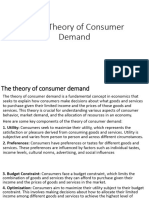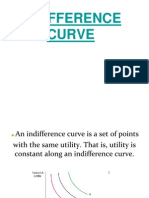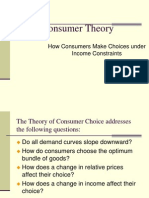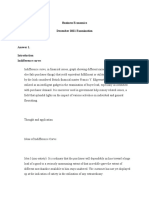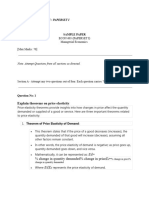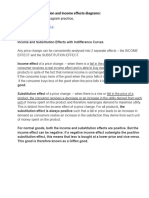Indifference Curve
Indifference Curve
Uploaded by
Siva WindriyaniCopyright:
Available Formats
Indifference Curve
Indifference Curve
Uploaded by
Siva WindriyaniOriginal Title
Copyright
Available Formats
Share this document
Did you find this document useful?
Is this content inappropriate?
Copyright:
Available Formats
Indifference Curve
Indifference Curve
Uploaded by
Siva WindriyaniCopyright:
Available Formats
INDIFFERENCE CURVE
Indifference curves is a curve connecting the points of combinations of consumption (or
purchases) of goods that result in the same level of satisfaction. Indifference curve shows all
combinations of consumer choices that provide the same level of satisfaction or utility for a
person or consumer.
Indifference Curve Characteristics:
−Has a negative slope (consumers will reduce the consumption of one good if he increases
the number of other goods consumed).
−Convex towards the point of origin, indicating that there is a difference in the proportion of
the amount that must be sacrificed to change the combination of the amount of each item
consumed (marginal rate of substitution).
−Not intersecting, it is impossible to obtain the same satisfaction on a different indifference
curve.
Some assumptions that must exist in the ordinal approach in the formation of
indifference curves that must be obeyed, namely:
−Rationality, consumers are assumed to be rational, meaning that consumers maximize
utility with income at certain market prices and consumers are considered to have perfect
knowledge of market information.
−Utility is ordinal in nature, meaning that it is enough for the consumer to provide a ranking
or rating of whichever combination he likes, so that the consumer does not need to provide a
unit of satisfaction for the goods consumed.
−Adhering to the law of diminishing marginal rate of substitution means that if consumers
increase the consumption of one good it will cause a decrease in the consumption of other
goods and can be described by an indifference curve.
−Total Utility obtained by consumers depends on the amount of goods consumed.
−It is consistent and transivity of choice means that if A>B>C then item A is preferred over B
and item B is preferred over C, the conclusion is that A>B>C then A>C.
Indifference Curve Shape:
Indifference Curve Properties
1. Higher indifference curves are preferred over lower ones
−Each consumer usually prefers to be able to consume goods in greater quantities.
−A higher indifference curve represents the availability of more goods than the curve
below it.
2. The indifference curve curves downward
−Consumers are willing to exchange an item if they get more of another item to get
the same satisfaction.
−If the quantity of one good decreases, the quantity of another good must increase.
3. Indifference curves do not intersect (transivity principle)
−Points A and B provide the same satisfaction for consumers.
−Points B and C provide the same satisfaction for consumers.
−This means that points A and C will provide the same satisfaction for consumers.
−Even though point C contains more goods than point A.
4. More is better, a lot is preferable to a little
Indifference curves that are on the right side are preferred, because more is better
You might also like
- 7100 Scheme of Work (For Examination From 2021)Document44 pages7100 Scheme of Work (For Examination From 2021)Saman NizamiNo ratings yet
- Microeconomics: QuickStudy Laminated Reference GuideFrom EverandMicroeconomics: QuickStudy Laminated Reference GuideRating: 5 out of 5 stars5/5 (1)
- Course Outline: Subject Code: Eco. BBA - 1205 Subject: (Introduction To Business) Semester: BBA 1Document5 pagesCourse Outline: Subject Code: Eco. BBA - 1205 Subject: (Introduction To Business) Semester: BBA 1Muhammad Hameed50% (2)
- Indifference Curve Analysis PDFDocument24 pagesIndifference Curve Analysis PDFArpita BanerjeeNo ratings yet
- Lecture-5 - Ordinal ApproachDocument10 pagesLecture-5 - Ordinal Approachrimapatra144No ratings yet
- Theory of Consumer ChoiceDocument9 pagesTheory of Consumer ChoiceAbhijit SarkarNo ratings yet
- Group_6_BasicMicroDocument5 pagesGroup_6_BasicMicroliquiran.levi27No ratings yet
- Indifference Curve Theory Notes 2022Document16 pagesIndifference Curve Theory Notes 2022derivlimitedsvgNo ratings yet
- The Theory of Individual BehaviorDocument3 pagesThe Theory of Individual Behaviorbebanco.maryzarianna.olaveNo ratings yet
- Consumer BehaviorDocument15 pagesConsumer BehaviorSamia RasheedNo ratings yet
- Applied Economics Unit-2 Theory of Consumer Demand 6LhrDocument47 pagesApplied Economics Unit-2 Theory of Consumer Demand 6Lhrsusanttiwari2048No ratings yet
- Ind. Curve and BL Term 3Document31 pagesInd. Curve and BL Term 3richmonfNo ratings yet
- Indifference Curve EditedDocument18 pagesIndifference Curve Editedameeshapanwar1No ratings yet
- Indifference Curve Analysis in Consumer BehaviorDocument2 pagesIndifference Curve Analysis in Consumer Behaviorkhushal20600k.sNo ratings yet
- Distinguish Between Cardinal and Ordinal Approach To Explain The ConsumerDocument10 pagesDistinguish Between Cardinal and Ordinal Approach To Explain The ConsumerPoonam ThapaNo ratings yet
- Chapter 6Document2 pagesChapter 6John Mark TabusoNo ratings yet
- Economics Unit 1: Indifference Curve Analysis DemandDocument22 pagesEconomics Unit 1: Indifference Curve Analysis DemandDarryl SaundersNo ratings yet
- UNIT-II - Ordinal ApproachDocument27 pagesUNIT-II - Ordinal ApproachSuhani100% (1)
- Consumer Behaviour and Utility Maximisation: Utility Theory of Utility Measurement. - Consumers' Satisfaction IsDocument5 pagesConsumer Behaviour and Utility Maximisation: Utility Theory of Utility Measurement. - Consumers' Satisfaction IsnelsNo ratings yet
- A. Theory:: 1. The Budget Constraint - What The Consumer Can AffordDocument3 pagesA. Theory:: 1. The Budget Constraint - What The Consumer Can AffordHuong Mai VuNo ratings yet
- Indifference CurveDocument14 pagesIndifference Curverajeevbhandari82@gmail.comNo ratings yet
- Intermediate MicroeconomicsDocument35 pagesIntermediate MicroeconomicsJulia KimberlyNo ratings yet
- Consumer Behavior Approaches Consumer EquilibriumDocument44 pagesConsumer Behavior Approaches Consumer EquilibriumNanda Kumar100% (2)
- Consumer Choice and Demand DecisionsDocument40 pagesConsumer Choice and Demand DecisionsNelly OdehNo ratings yet
- 11 Economic Cours 3&4Document41 pages11 Economic Cours 3&4tegegn mehademNo ratings yet
- Unit 3 Grade 11Document38 pagesUnit 3 Grade 11Breket WonberaNo ratings yet
- BUSINESS EcoDocument11 pagesBUSINESS EcoRajat madnani 1003No ratings yet
- Consumer BehaviorDocument7 pagesConsumer BehaviorWondimu Mekonnen ShibruNo ratings yet
- Grade 11 Economics Module 1Document28 pagesGrade 11 Economics Module 1Ashenafi Legese SegniNo ratings yet
- The law of diminishing marginal utilityDocument16 pagesThe law of diminishing marginal utilityAsma Rahmat RikaNo ratings yet
- Analysis of Consumer Behaviour-Indifference Curves TechniqueDocument31 pagesAnalysis of Consumer Behaviour-Indifference Curves Techniquemohammed junaidNo ratings yet
- Chapter 21Document5 pagesChapter 21Gia HânNo ratings yet
- Theory of Consumer BehaviourDocument26 pagesTheory of Consumer BehaviourBikram SaikiaNo ratings yet
- Chapter 4-Consumer BehaviorDocument6 pagesChapter 4-Consumer BehaviorLina AnwarNo ratings yet
- Consumer TheoryDocument15 pagesConsumer TheoryEdwince OchiengNo ratings yet
- Grade 11 Economics Entrance NoteDocument22 pagesGrade 11 Economics Entrance Notebonadeleleng12No ratings yet
- Microeconomics Chapter 3Document5 pagesMicroeconomics Chapter 3Alejandra jpNo ratings yet
- Arbaminch University: Arbaminch Institute of TechnologyDocument11 pagesArbaminch University: Arbaminch Institute of Technologyyohannisyohannis54No ratings yet
- UtilityDocument51 pagesUtilityVikram Jhalani100% (1)
- Chapter 2 Theory of Consumer BehaviourDocument10 pagesChapter 2 Theory of Consumer Behavioursujeetbth362No ratings yet
- What is Indifference Curve Explain the Properties ..Document1 pageWhat is Indifference Curve Explain the Properties ..Jhalak SinghNo ratings yet
- Theory of Consumer BehaviourDocument65 pagesTheory of Consumer BehaviourAryan AggarwalNo ratings yet
- Utility and Indifference CurvesDocument6 pagesUtility and Indifference CurvesPriscilla MungatiNo ratings yet
- Utility Note 2Document17 pagesUtility Note 2tamalbanikcuNo ratings yet
- Review of The Previous LectureDocument21 pagesReview of The Previous LectureMuhammad Usman AshrafNo ratings yet
- ECN 2111: Microeconomics: 21. The Theory of Consumer ChoiceDocument34 pagesECN 2111: Microeconomics: 21. The Theory of Consumer ChoiceFabiha TabassumNo ratings yet
- Utility_newDocument49 pagesUtility_newutkarshumangkotaNo ratings yet
- Consumer BehaviorDocument3 pagesConsumer BehaviorShakeel AbbasiNo ratings yet
- Model QuestionDocument16 pagesModel Questionarpitas16No ratings yet
- Indifference Curves Definition:: Budget: $90 BeforeDocument1 pageIndifference Curves Definition:: Budget: $90 BeforeNeha NathaNo ratings yet
- Indifference CurveDocument12 pagesIndifference CurvevaibhavNo ratings yet
- Answer 1. Indifference Curve:: Business Economics December 2021 ExaminationDocument15 pagesAnswer 1. Indifference Curve:: Business Economics December 2021 ExaminationAssignment HuntNo ratings yet
- Chapter 3 - Consumer BehaviourDocument17 pagesChapter 3 - Consumer BehaviourKaranNo ratings yet
- Indifference-Curves-Understanding-Consumer-Preferences2Document8 pagesIndifference-Curves-Understanding-Consumer-Preferences2rudrafundsNo ratings yet
- Consumer's EquilibriumDocument37 pagesConsumer's EquilibriumSoumendra Roy67% (3)
- Managerial Economics-Sample QPDocument17 pagesManagerial Economics-Sample QPsharmapallavi902No ratings yet
- Ordinal Utility TheoryDocument2 pagesOrdinal Utility Theoryyihepi5639No ratings yet
- Assignment - Managerial Economics Riya Singh 19FLICDDNO1106Document4 pagesAssignment - Managerial Economics Riya Singh 19FLICDDNO1106riyaNo ratings yet
- Practice of Substitution and Income Effects Diagrams 1Document9 pagesPractice of Substitution and Income Effects Diagrams 1msana6348No ratings yet
- The Theory of Consumer BehaviourDocument30 pagesThe Theory of Consumer BehaviourMiswar ZahriNo ratings yet
- Consumer Behavior Analysis: Ordinal Utility Approach: Meaning of Indifference CurveDocument1 pageConsumer Behavior Analysis: Ordinal Utility Approach: Meaning of Indifference CurveYashika MadanNo ratings yet
- Foe - Unit IiDocument28 pagesFoe - Unit IiKeerthi PriyadarshiniNo ratings yet
- PreviewpdfDocument84 pagesPreviewpdfMe MeNo ratings yet
- As Public Merit Demerit GoodsDocument7 pagesAs Public Merit Demerit GoodsAssfaw KebedeNo ratings yet
- 2020 Busstu GR 10 Notes Chapt 3Document4 pages2020 Busstu GR 10 Notes Chapt 3ThinkingtoomuchNo ratings yet
- Materials For Damp Proof CourseDocument2 pagesMaterials For Damp Proof CourseSyed Mohd MehdiNo ratings yet
- DR SafiDocument161 pagesDR SafiransinghNo ratings yet
- MCP N1Document165 pagesMCP N1Surya SolankiNo ratings yet
- Marketing Management and International TradeDocument171 pagesMarketing Management and International TradeNitinNo ratings yet
- Law of Demand, Elasticity of DemandDocument90 pagesLaw of Demand, Elasticity of DemandDr. Rakesh BhatiNo ratings yet
- FMCG in AfricaDocument2 pagesFMCG in AfricaAnunobi JaneNo ratings yet
- Circumference of Pipe For InsulationDocument1 pageCircumference of Pipe For Insulationanishj2k100% (2)
- Circular Flow DiagramDocument14 pagesCircular Flow DiagramAldo Kris BarliantoNo ratings yet
- Mathematical Representation. Explain Veblen Goods and Giffen GoodsDocument19 pagesMathematical Representation. Explain Veblen Goods and Giffen GoodsIshaan S MoudgalNo ratings yet
- Principles of Agricultural MarketingDocument21 pagesPrinciples of Agricultural Marketingagricultural and biosystems engineering100% (2)
- A Study On Retailers Satisfaction Towards Britania Distribution With Reference To Vishalakshi Distributors at DindigulDocument92 pagesA Study On Retailers Satisfaction Towards Britania Distribution With Reference To Vishalakshi Distributors at DindigulHussainNo ratings yet
- Cbme Reviewer MidtermDocument35 pagesCbme Reviewer Midtermangelafernandez0309No ratings yet
- Consumer Protection ActDocument19 pagesConsumer Protection ActthachuuuNo ratings yet
- Chapter 4 Elasticity Test and AnswerDocument13 pagesChapter 4 Elasticity Test and AnswerWendors Wendors100% (3)
- IELTS Ebook Luxury GoodsDocument14 pagesIELTS Ebook Luxury GoodsNgọc NgânNo ratings yet
- EE Week 1-1Document27 pagesEE Week 1-1ferewe tesfayeNo ratings yet
- Applied Economics - Chapter 1Document86 pagesApplied Economics - Chapter 1Nyliram MarilynNo ratings yet
- Product and Brand ManagementDocument89 pagesProduct and Brand Managementanhphuong.forworkNo ratings yet
- AQA Specimen Paper 1 AS MCQsDocument28 pagesAQA Specimen Paper 1 AS MCQsTahmid SiraziNo ratings yet
- AC505: Product Cost PlanningDocument4 pagesAC505: Product Cost PlanningAdam OngNo ratings yet
- Operations StrategyDocument73 pagesOperations StrategyKiran MittalNo ratings yet
- Tourism Transport OperationsDocument5 pagesTourism Transport OperationsSlurpie PieNo ratings yet
- MCBEN AV003K46 TLOTT Trần-Hoàng-Anh-Thư1Document22 pagesMCBEN AV003K46 TLOTT Trần-Hoàng-Anh-Thư1Quốc BảoNo ratings yet
- Transportation ProblemDocument13 pagesTransportation ProblemAditi RustagiNo ratings yet
- Entrp Modul 3 Grade 10Document44 pagesEntrp Modul 3 Grade 10bryan tolab83% (6)










